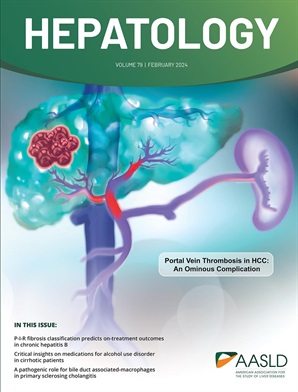肝内胆管癌肿瘤微环境异质性和进展机制:基于单细胞和空间转录组测序的研究
IF 12.9
1区 医学
Q1 GASTROENTEROLOGY & HEPATOLOGY
引用次数: 0
摘要
背景与目的:肝内胆管癌(ICC)具有高度恶性的特点,预计在过去几十年中其全球发病率将继续增加。然而,ICC的发病和进展机制尚不清楚。方法和结果:训练队列包括12个treatment-naïve ICC样本的单细胞测序和4个ICC样本的空间转录组学。验证队列包括来自87个ICC肿瘤样本的RNA-seq数据。最后,我们通过多重免疫荧光、类器官和小鼠模型在体内和体外验证了我们的发现。我们发现ICC患者的肿瘤微环境(TME)存在显著的异质性。ICC细胞被划分为5个分子亚型,我们发现天冬氨酸β -羟化酶(ASPH)是入侵亚型的标记基因。然后我们选择头孢酞氨酸(CEP)作为一种有效抑制肿瘤进展的ASPH抑制剂。关于ICC淋巴转移机制,我们发现N1淋巴结肿瘤细胞高表达肿瘤特异性MHC-II分子,但缺乏共刺激因子CD80/CD86,诱导CD4+ T细胞处于能量状态,可能促进ICC免疫逃逸。结论:ICC的TME具有异质性。ASPH抑制剂CEP可显著抑制ICC的进展,可作为ICC的靶向治疗药物。N1淋巴结的肿瘤细胞表现出肿瘤特异性MHC-II分子的高表达,但CD80/CD86等共刺激因子的沉默可诱导CD4+ T细胞进入无能状态。我们的研究表明,ASPH和MHC-II可能成为ICC的新治疗靶点。本文章由计算机程序翻译,如有差异,请以英文原文为准。
Tumor microenvironment heterogeneity and progression mechanisms in intrahepatic cholangiocarcinoma: A study based on single-cell and spatial transcriptomic sequencing
Background and Aims: Intrahepatic cholangiocarcinoma (ICC) is characterized by high malignancy, and its global incidence is predicted to continue to increase over the past decades. However, the mechanisms underlying ICC pathogenesis and progression remain unclear. Approach and Results: The training cohort consisted of single-cell sequencing of 12 treatment-naïve ICC samples and spatial transcriptomics of four ICC samples. The validation cohort comprised of RNA-seq data from 87 ICC tumor samples. Finally, we validated our findings via multiplex immunofluorescence, organoids, and mice models both in vivo and in vitro . We found significant heterogeneity within the tumor microenvironment (TME) of ICC patients. ICC cells were classified into five molecular subtypes, and we revealed that aspartate beta-hydroxylase (ASPH) was a marker gene for invasion subtypes. We then selected cepharanthine (CEP) as an ASPH inhibitor that effectively suppressed tumor progression. Regarding the ICC lymphatic metastasis mechanism, we found that tumor cells in N1 lymph nodes highly expressed tumor-specific MHC-II molecules but lacked co-stimulatory factors CD80/CD86, inducing a state of anergy in CD4+ T cells, which might facilitate ICC immune evasion. Conclusions: The TME of ICC was heterogeneous. ASPH markedly enhanced ICC invasion The ASPH inhibitor CEP significantly inhibits ICC progression and may serve as a targeted therapeutic drug for ICC. Tumor cells in N1 lymph nodes demonstrate high expression of tumor-specific MHC-II molecules, but silencing of co-stimulatory factors such as CD80/CD86 induces CD4+ T cells into an anergic state. Our study indicated that ASPH and MHC-II may serve as novel therapeutic targets for ICC.
求助全文
通过发布文献求助,成功后即可免费获取论文全文。
去求助
来源期刊

Hepatology
医学-胃肠肝病学
CiteScore
27.50
自引率
3.70%
发文量
609
审稿时长
1 months
期刊介绍:
HEPATOLOGY is recognized as the leading publication in the field of liver disease. It features original, peer-reviewed articles covering various aspects of liver structure, function, and disease. The journal's distinguished Editorial Board carefully selects the best articles each month, focusing on topics including immunology, chronic hepatitis, viral hepatitis, cirrhosis, genetic and metabolic liver diseases, liver cancer, and drug metabolism.
 求助内容:
求助内容: 应助结果提醒方式:
应助结果提醒方式:


